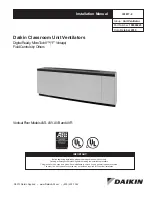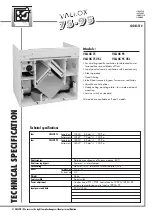
5
Reinigung durch Ex-Schutz-Elektrofachkraft
Ventilator
regelmäßig
, in angemessenen Zeitab-
ständen mit einem feuchten Tuch reinigen, beson-
ders nach längerem Stillstand.
Ventilator in
kürzeren Zeitabständen
reinigen,
wenn zu erwarten ist, dass sich auf dem Flügelrad
und anderen Bauteilen des Ventilators Staubschich-
ten ablagern.
Instandhaltung
durch Ex-Schutz-Elektrofachkraft
Der Ventilator ist regelmäßig zu prüfen und zu war-
ten. Insbesondere sicherzustellen ist:
●
die ungehinderte Strömung im Luftkanal.
●
die Wirksamkeit der Schutzgitter.
●
die Einhaltung der zulässigen Temperaturen.
●
der ruhige Lauf der Lager. Lagerlebensdauer
40000 Stunden, abhängig von der Anwendung.
●
der feste Sitz der Leitungen im Klemmenkasten.
●
keine Beschädigungen von Klemmenkasten,
Kabelverschraubungen, Verschlussstopfen und
Leitungen.
●
die feste Verlegung der Leitungen.
Bei regelmäßigen Sicherheitsprüfungen (Instandhal-
tungsintervall) eine komplette Überprüfung gemäß den
Prüfplänen in Kapitel 16, 17 und 18 vornehmen.
Dabei die Funktion von Sicherheitsbauteilen, Luftspalt,
Stromaufnahme, Lagergeräusche, Beschädigungen
und unverhältnismäßige Schwingungen (z. B. Un-
wucht des Flügelrades) prüfen. Verschmutzungen und
Fremdpartikel entfernen.
Reparaturen
Bei Abnutzung/Verschleiß von Gerätekomponenten
den Ventilator in unser Werk schicken. Austausch von
Gerätekomponenten bzw. Reparaturen sind nur
im Herstellerwerk zulässig.
20 Störungsbeseitigung
Kapitel 11, Verhalten bei einer Störung.
21 Demontage, umweltgerechte Entsorgung
!
GEFAHR
Gefahr durch elektrischen Schlag.
Vor Zugang
zu den Anschlussklemmen alle Versorgungsstrom-
kreise freischalten, gegen Wiedereinschalten
sichern, Spannungsfreiheit feststellen, erden und
die ERDE mit kurzzuschließenden aktiven Teilen
verbinden, und benachbarte, unter Spannung
stehende Teile abdecken oder abschranken.
Warnschild sichtbar anbringen.
Sicherstellen, dass
keine explosive Atmosphäre vorhanden ist.
●
Demontage nur durch im Ex-Schutz geschulte
und befugte Elektrofachkräfte zulässig.
●
Altgeräte nach deren Nutzungsende umwelt-
gerecht gemäß den örtlichen Bestimmungen
entsorgen.
Mounting and operating instructions
Semi-centrifugal duct fans for
use in potentially explosive
atmospheres
The unit is manufactured in accordance with the
ATEX Directive 2014/34/EU (previously Directive
94/9/EC) and is suitable for areas subject to explo-
sion hazards.
Before mounting and using the fan for the first
time, read these instructions carefully and follow
the information they contain.
The warnings provided indicate hazard situations
which result/could result in death or serious injury
(DANGER / WARNING) or minor injury (CAUTION)
if not avoided.
NOTICE
indicates potential damage
to the product or its surroundings. Keep the instruc-
tions safe for use later on.
1 Figures
Fig. A:
Dimensions, sound power level
Fig. B:
Installation example:
1 Ventilation duct, to be supplied by the customer
2 flexible cuffs, optional
3 reducer
4 Terminal box
5 Ceiling, girder
6 mounting foot, optional
7 duct fan
Fig. C:
protective grille, optional
Fig. D:
Wiring diagram
For air flow direction / direction of rotation
Arrows
on plastic housing
Chap. 17
2 Scope of delivery
Fan with connecting cable and explosion protection
terminal box (connecting cable pre-wired), mount-
ing and operating instructions. For fan serial no.
Rating plate on fan. EC declaration of conformity at
the end of these instructions
.
3
Qualification of installation, cleaning,
maintenance and repair staff
Mounting, commissioning, cleaning and maintenan-
ce may only be undertaken
by electricians trained
and authorised in explosion protection. Fans
may only be repaired in the manufacturer’s
factory.
You are considered an electrician trained in explo-
sion protection if your specialist training and experi-
ence enables you to correctly and safely undertake
installation and electrical connections in accordance
with the wiring diagrams provided in these instruc-
tions. In addition, you must be able to recognise,
assess and avoid ignition and explosion hazards
and risks caused by incorrect installation, electricity,
electrostatic discharge etc.
4 Intended use
The fan is used for air extraction or ventilation of
rooms used for commercial purposes (dye shop,
battery room, commercial premises, production fa-
cilities, etc.) with potentially explosive atmospheres.
The fan fulfils the safety requirements of Directive
2014/34/EU for units and protective systems in
areas subject to explosion hazards.
The unit is classified as group II, category 2G, satis
-
fies type of protection “e” and is suitable for use in
zone 1 and 2 areas subject to explosion hazards.
For outdoor applications the device must be fully
protected against weather influences.
5 Non-intended use
The fan unit must not be used in the following
situations under any circumstances. There is a
risk of death. Read all the safety instructions.
UK
DE
EX
EXPLOSION HAZARD
!
Explosion hazard due to ignition of explo-
sive substances if operating without
motor
protection switch
.
Only operate fan with an ad-
ditional
motor protection switch
in accordance with
Directive 2014/34/EU.
!
Explosion hazardfrom operating several
fans in parallel with one single motor protec-
tion switch. Reliable tripping is not always
guaranteed in the event of a fault.
Do not under any circumstances operate several
fans in parallel with one single PTC thermistor
triggering device.
!
Explosion hazard due to spark formation
by the impeller scraping on the housing if the
air gap is too small.
Ensure a large enough air
gap all the way round between the impeller and
housing.
!
Explosion hazard when moving explosive
dusts or solid/liquid particles (e.g. dye), which
may stick to the fan
.
Do not under any circum-
stances use fan to move explosive dusts or solid/
liquid particles.
!
Explosion hazard when operating outside
the ambient and operating conditions, especial-
ly due to overheating when operatingoutside
the permitted usage temperature.
Only operate fan within the permitted ambient
and operating conditions and permitted usage
temperature.
!
Explosion hazard when operating without
protective device should foreign bodies fall or
be drawn into the air channel
Risk of death
due to spark formation.
Be sure to fit a protective
device according to EN 60529, e.g. protective grille
on an uncovered air inlet/outlet. Protection against
reaching in (protective grille in accordance with
EN 13857) is required on both sides.
!
Explosion hazard if the explosive atmos-
phere cannot be removed if the supply air in-
take is insufficient
. This can arise if e.g. rooms
are too air-tight or room filters are clogged.
Ensure sufficient supply air intake. Operate fan in
permissible air power range.
!
Explosion hazard when operating with
frequency converter for speed control. Bearing
currents may be a direct source of ignition.
Operation with frequency converter not permitted.
!
Explosion hazard due to unauthorised
conversions on unit, incorrect mounting or
damaged components. Danger if installation/
modification work is carried out by unqualified
staff.
Operation not permitted if unit is modified,
mounting is incorrect or components are dam-
aged. Unit is not approved if mounting
work is carried out by unqualified staff.
!
CAUTION
Danger of injury if there is no protection
against reaching in/contact (protective grille)
on uncovered air inlet/outlet, especially if
people can access the fan.
Fan may only be operated with
protection against
reaching in
on both sides
. Areas with potential
access to rotating parts (impeller) should be made
safe with protection against reaching in in accord-
ance with EN ISO 13857, e.g. protective grille.
6 Motor protection switch needed
Motor protection switches which meet the following
conditions are permitted, otherwise the conformity
ceases to apply:
●
Type-examination in accordance with Directive
2014/34/EU.


































